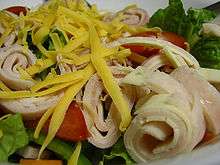Chef salad
|
| |
| Alternative names | Chef's salad |
|---|---|
| Type | Salad |
| Main ingredients | Hard-boiled eggs, tomatoes, cucumbers, cheese |

Chef salad (or chef's salad) is an American salad consisting of hard-boiled eggs; one or more varieties of meat, such as ham, turkey, chicken, or roast beef; tomatoes; cucumbers; and cheese; all placed upon a bed of tossed lettuce or other leaf vegetables. Several early recipes also include anchovies. A variety of dressings may be used with this salad.
Food historians do not agree on the history and composition of chef salad, much less who assembled the first one. Some trace this salad's roots to Salmagundi, a popular meat and salad dish originating in 17th century England and popular in colonial America. Others contend chef's salad is a product of early twentieth century, originating in either New York or California. The person most often connected with the history of this salad is Louis Diat, chef of the Ritz-Carlton in New York City during the 1940s. While food historians acknowledge his recipe, they do not appear to be convinced he originated the dish, which is more popularly attributed to either chef Victor Seydoux at the Hotel Buffalo, a Statler Hotel in Buffalo, New York or to chef Jacques Roser[1] at the Hotel Pennsylvania in New York City. Roser worked in various culinary positions in Paris before being invited to become head chef at the prestigious 1920s Hotel Pennsylvania, where he worked for over fifteen years. Seydoux first learned his craft in Montreux, Switzerland, and continued his studies in France and England before coming to work in the United States.
Seydoux's first experiences in the U.S. included positions at the Waldorf-Astoria Hotel and the Ritz-Carlton.[2][3] Although the origin of the salad is not generally known, as reported by Alice Rose Seydoux, widow of Victor, the salad was officially launched at the Hotel Buffalo. When the customers started requesting the off-menu salad made with cuts of meat, cheese and hard boiled eggs, the hotel decided to add it to the menu. Giving chef Seydoux the honor of naming the salad he is purported to have said "Well, it's really a chef's salad."
The chef salad probably owes much of its popularity, according to Evan Jones in American Food: The Gastronomic Story (1975), to Louis Diat, chef at the Ritz-Carlton. Cooking a la Ritz includes Diat's recipe: "Chef's salad. Place separately in a salad bowl equal amounts of chopped lettuce (place on the bottom of the bowl), boiled chicken, smoked ox tongue and smoked ham, all cut in julienne style. Add 1/2 hard-cooked egg for each portion. Place some watercress in the center and serve with French Dressing." Diat did not invent the salad (older recipes exist), but its inclusion on the menu at the Ritz-Carlton would have introduced the salad to more of the public. It is possible that the inclusion of Thousand Island dressing is also linked to the Ritz, since the hotel also introduced the dressing to New York City. This recipe, while containing smoked ox tongue, still contains the primary chef salad ingredients: meat, eggs, greens, as well as its presentation: julienne sliced meat and sliced eggs. Several other early chef salad recipes mention crumbling Roquefort cheese over the salad.
The 1936 2nd printing of The Joy of Cooking is the first known printed recipe[4] for a "Chef Salad" and cites many ingredients found in later Chef Salad recipes (but no meat).[5] On page 51 of his 1926 book “The Edgewater Beach Hotel Salad Book” author Arnold Shircliffe gives a recipe for the “Cook’s Salad” which employs many ingredients of later Chef Salads, including the garlic-rubbed salad bowl.[6] In a note following the 1926 recipe, Shircliffe shares a story on the origin of the "Cook’s Salad" in which he also references the “chef’s salad bowl,” though no biographical data is given:
“While passing through a kitchen one day, I found the above mixture in huge bowl in the center of the chef’s table, and being friendly to salads as well as cooks, I requested a sample and was served very liberally. The salad was delicious ; in fact it was a sort of master composition and deserving of an appropriate name. As nothing but the best of everything enters into the food materials supplied to chef's table, the salad was born and named “Cook’s Salad.’’ I have been more or less successful in ordering this particular salad; but if I wish to get this salmagundy right I order it from the chef’s table and not the salad pantry. The chef’s salad bowl is generally rubbed with garlic.”
See also
References
- ↑ http://www.ancestry.com/genealogy/records/jacques-roser_132517362
- ↑ Reppert, Sybil, (November 9, 1933) "Hungarian Goulash is Favorite Hotel Dish, Says Chef Seydoux," Buffalo Times "The Buffalo's chef learned to cook in Montreux, Switzerland, on the Lake of Geneva. He left his native land to go to London. Then he came to America to take a position in New York's Ritz Carlton hotel. He was chef in other New York hotels and in Rochester before he came to Buffalo."
- ↑ Statler Salesmanship (October 1926) "Like most of our Chefs, Mr. Seydoux learned his craft abroad, starting in his own home town of Montreux, Switzerland and finishing his training in the Palace Hotel at Vevey. After experience in some of the best hotels in France and England, he came to America as "Potager" of the Ritz-Carlton in New York City. His experience in this country included position at the Belmont, Waldorf-Astoria and McAlpin Hotels in New York..."
- ↑ Oliver, Lynne (2000). The Food Timeline.
- ↑ Rombauer, Irma S. (1936). The Joy of Cooking. Boggs-Merrill Company. p. 266. ISBN 0-02-604570-2.
- ↑ https://archive.org/stream/McGillLibrary-104445-108/104445_djvu.txt